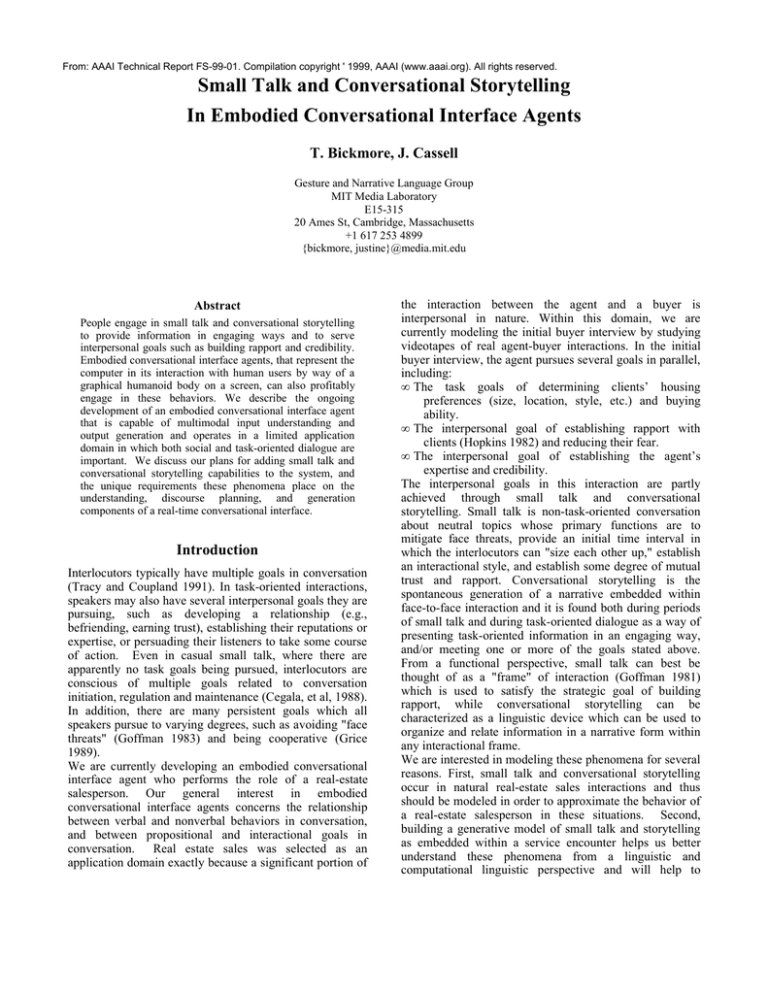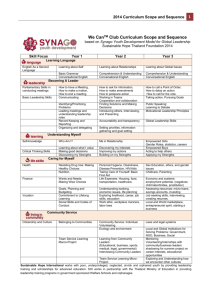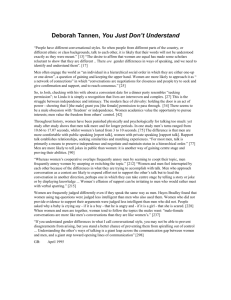
From: AAAI Technical Report FS-99-01. Compilation copyright ' 1999, AAAI (www.aaai.org). All rights reserved.
Small Talk and Conversational Storytelling
In Embodied Conversational Interface Agents
T. Bickmore, J. Cassell
Gesture and Narrative Language Group
MIT Media Laboratory
E15-315
20 Ames St, Cambridge, Massachusetts
+1 617 253 4899
{bickmore, justine}@media.mit.edu
Abstract
People engage in small talk and conversational storytelling
to provide information in engaging ways and to serve
interpersonal goals such as building rapport and credibility.
Embodied conversational interface agents, that represent the
computer in its interaction with human users by way of a
graphical humanoid body on a screen, can also profitably
engage in these behaviors. We describe the ongoing
development of an embodied conversational interface agent
that is capable of multimodal input understanding and
output generation and operates in a limited application
domain in which both social and task-oriented dialogue are
important. We discuss our plans for adding small talk and
conversational storytelling capabilities to the system, and
the unique requirements these phenomena place on the
understanding, discourse planning, and generation
components of a real-time conversational interface.
Introduction
Interlocutors typically have multiple goals in conversation
(Tracy and Coupland 1991). In task-oriented interactions,
speakers may also have several interpersonal goals they are
pursuing, such as developing a relationship (e.g.,
befriending, earning trust), establishing their reputations or
expertise, or persuading their listeners to take some course
of action. Even in casual small talk, where there are
apparently no task goals being pursued, interlocutors are
conscious of multiple goals related to conversation
initiation, regulation and maintenance (Cegala, et al, 1988).
In addition, there are many persistent goals which all
speakers pursue to varying degrees, such as avoiding "face
threats" (Goffman 1983) and being cooperative (Grice
1989).
We are currently developing an embodied conversational
interface agent who performs the role of a real-estate
salesperson. Our general interest in embodied
conversational interface agents concerns the relationship
between verbal and nonverbal behaviors in conversation,
and between propositional and interactional goals in
conversation. Real estate sales was selected as an
application domain exactly because a significant portion of
the interaction between the agent and a buyer is
interpersonal in nature. Within this domain, we are
currently modeling the initial buyer interview by studying
videotapes of real agent-buyer interactions. In the initial
buyer interview, the agent pursues several goals in parallel,
including:
• The task goals of determining clients’ housing
preferences (size, location, style, etc.) and buying
ability.
• The interpersonal goal of establishing rapport with
clients (Hopkins 1982) and reducing their fear.
• The interpersonal goal of establishing the agent’s
expertise and credibility.
The interpersonal goals in this interaction are partly
achieved through small talk and conversational
storytelling. Small talk is non-task-oriented conversation
about neutral topics whose primary functions are to
mitigate face threats, provide an initial time interval in
which the interlocutors can "size each other up," establish
an interactional style, and establish some degree of mutual
trust and rapport. Conversational storytelling is the
spontaneous generation of a narrative embedded within
face-to-face interaction and it is found both during periods
of small talk and during task-oriented dialogue as a way of
presenting task-oriented information in an engaging way,
and/or meeting one or more of the goals stated above.
From a functional perspective, small talk can best be
thought of as a "frame" of interaction (Goffman 1981)
which is used to satisfy the strategic goal of building
rapport, while conversational storytelling can be
characterized as a linguistic device which can be used to
organize and relate information in a narrative form within
any interactional frame.
We are interested in modeling these phenomena for several
reasons. First, small talk and conversational storytelling
occur in natural real-estate sales interactions and thus
should be modeled in order to approximate the behavior of
a real-estate salesperson in these situations. Second,
building a generative model of small talk and storytelling
as embedded within a service encounter helps us better
understand these phenomena from a linguistic and
computational linguistic perspective and will help to
uncover deeper theoretical issues in constructing systems
capable of real-time dialogue that is not strictly taskoriented. Finally, we feel that these behaviors do play a
crucial role in the real-estate sales process and thus must be
incorporated into a system that is to perform this role
competently.
We begin this paper by presenting our development
platform for building embodied conversational interface
agents along with the current application domain of realestate sales. We then describe small talk and
conversational storytelling from a linguistic perspective,
and discuss the requirements these capabilities place on a
real-time conversational interface. Finally, we discuss
some of the specific challenges we face in adding these
capabilities to our system.
REA: An Embodied conversational interface
agent
In conversation one of the primary purposes of rapportbuilding behaviors is to establish that our interlocutor is, in
some way, "just like us," that is, shares our basic values
and beliefs, as well as sharing the ability to communicate
(Laver 1981). One way for a software agent to overcome
the credibility problem is to embody the agent in the
interface, that is, provide it with a human appearance and
lifelike behavior. It has been shown that people tend to
treat computers as social agents anyway (Reeves and Nass,
1996), but providing an agent with an embodied presence
provides a strong cue to users that the agent should be
treated and interacted with as another person. To further
support this image of computer-as-conversational-partner,
we feel it is crucial that user and computer be able to use
the face, hands, and melody of the voice in interaction to
regulate the process of their conversation, as well as the
ability to use verbal and nonverbal means to contribute
content to the ongoing conversation (Cassell et al, 1999).
In one study of personified interfaces, characters with
realistic human faces were rated over characters with
caricatures and animal faces as the "most intelligent," even
though the behavior models underlying the different
characters was the same (Koda and Maes, 1996).
The Rea project at the MIT Media Lab has as its goal the
construction of an embodied, multi-modal real-time
conversational interface agent. Rea implements the social,
linguistic, and psychological conventions of conversation
to make interactions as natural as face-to-face conversation
with another person. Rea differs from other dialogue
systems, and other interface agents in three ways:
• Rea has a human-like body, and uses her body in
human-like ways during the conversation. That is, she
uses eye gaze, body posture, hand gestures, and facial
displays to organize and regulate the conversation.
• The
underlying
approach
to
conversational
understanding and generation in Rea is based on
discourse functions. Thus, each of the user’s inputs are
interpreted in terms of its conversational function and
responses are generated according to the desired
function to be fulfilled. (Cassell, et. al., 1999).
• Rea is able to respond to visual, audio and speech cues
normally used in face to face conversation, such as
speech, shifts in gaze, gesture, and non-speech audio
(feedback sounds). She is also able to generate these
cues, ensuring a full symmetry between input and
output modalities.
Rea has a fully articulated graphical body, can sense the
user passively through cameras and audio input, and is
capable of speech with intonation, facial display, and
gestural output. The system currently consists of a large
projection screen on which Rea is displayed and which the
user stands in front of (see Figure 1). Two cameras
mounted on top of the projection screen track the user’s
head and hand positions in space. Users wear a microphone
for capturing speech input. A single SGI Octane computer
runs the graphics and conversation engine of Rea, while
several other computers manage the speech recognition
and generation and image processing.
Figure 1. User interacting with Rea
Rea is able to describe the features of the task domain
while also responding to the users’ verbal and non-verbal
input. When the user makes cues typically associated with
turn taking behavior such as gesturing, Rea allows herself
to be interrupted, and then takes the turn again when she is
able. She is able to initiate conversational repair when she
misunderstands what the user says, and can generate
combined voice and gestural output. Rea’s responses are
generated by an incremental natural language generation
engine based on (Stone, 1998) that has been extended to
synthesize redundant and complementary conversational
gestures synchronized with speech output.
Rea's task domain is real estate sales (REA is an acronym
for "Real Estate Agent"), and within this domain we are
currently focused on modeling the initial interview with a
prospective buyer. In a typical interview, we feel it is
important for Rea to engage in some amount of small talk
to build rapport with the user before going into the "sales"
conversational frame. The rapport may convince users that
Rea does in fact understand their communicative
behaviors, as well as convincing them that she knows what
she is talking about in the real estate domain.
Small Talk
Human social encounters between individuals who have
never met or are unfamiliar with each other are usually
initiated by small talk in which "light" conversation is
made about neutral topics (e.g., weather, aspects of the
interlocutor’s physical environment) or in which personal
experiences, preferences, and opinions are shared (Laver
1981). Even in business or sales meetings, it is customary
to begin with some amount of small talk before "getting
down to business" (at least in American culture). The
purpose of this small talk is primarily to build rapport and
trust among the interlocutors, provide time for them to
"size each other up", establish an interactional style, and to
allow them to establish their reputations (Dunbar 1996).
Although small talk is most noticeable at the margins of
conversational encounters, it can be used at various points
in the interaction to continue to build rapport and trust
(Cheepen 1988), and in real estate sales, a good agent will
continue to focus on building rapport throughout the
relationship with a buyer (Garros 1999).
Small talk has received sporadic treatment in the linguistics
literature, starting with the seminal work of Malinowski
(1923) who defined "phatic communion" as "a type of
speech in which ties of union are created by a mere
exchange of words". Small talk is the language used in
free, aimless social intercourse, which occurs when people
are relaxing or when they are accompanying "some manual
work by gossip quite unconnected with what they are
doing." Jacobson (1960) also included a "phatic function"
in his well-known conduit model of communication, which
is focused on the regulation of the conduit itself (as
opposed to the message, sender, or receiver). More recent
work has further characterized small talk by describing the
contexts in which it occurs, topics typically used, and even
grammars which define its surface form in certain domains
(Laver 1975, Cheepen 1988, Schneider 1988). In addition,
degree of "phaticity" has been proposed as a persistent goal
which governs the degree of politeness in all utterances a
speaker makes, including task-oriented ones (Coupland
and Coupland 1992).
Phatic communion is closely related to the notion of "face"
(Goffman 1983); "positive face" is the desire of all
speakers to be approved of by their listeners, while
"negative face" is the desire of all speakers to be
unobstructed in their autonomy. Small talk mitigates
positive face threats by providing an interactional style in
which it is very easy (even somewhat obligatory) for all
interlocutors to carry on a conversation and thereby
achieve some degree of cameraderie. It can also be used to
mitigate negative face threats by establishing that one’s
interlocutors are non-hostile (e.g., as used to break uneasy
silences in waiting rooms).
The effectiveness of small talk on the user’s perception of a
software agent has been demonstrated in text-only
"chatterbot" systems such as ELIZA (Weizenbaum 1966).
There are many documented cases in which users have
established on-going relationships with such systems, even
when they knew that the system did not understand what
they were typing (Turkle 1995).
In the real-estate domain, we plan to utilize small talk to
establish trust and rapport between the Rea and the user in
such a way that the user relaxes enough to use normal
speech and nonverbal behaviors, and also feels comfortable
disclosing personal information (such as salary). Through
the introduction of a metric of interpersonal distance which
varies from "strangers" to "intimates", the discourse
planner can actually plan to conduct small talk by adding a
requisite level of interpersonal distance to the
preconditions for asking particular questions. For example,
before Rea asks the user invasive questions about financial
status (a negative face threat) she should first establish
some level of rapport, and this rapport might be achieved
by conducting some amount of small talk.
Conversational Storytelling
It would not be appropriate for Rea to tell tall tales, or spin
fantastic yarns. For this reason, we follow the literature on
conversational storytelling, and consider stories to be
"specific, affirmative, past time narratives which tell about
a series of events which did take place at specific unique
moments in a unique past time world" and which are told
to others to make a point or transmit a message (Polanyi
1985). In casual conversation, stories are often used to
relate interesting events or humor and thus contribute to
the rapport-building function.
We believe conversational storytelling should be an
integral part of an agent’s small talk capability. (Cheepen
1988, actually characterizes most of the exchanges in small
talk as story contributions.) One of the tricks that
chatterbot programs use to convey the illusion of
intelligence is to tell stories whenever possible in the
course of the conversation (Mauldin 1994), a technique
that is also espoused in several popular press books on
conversational skills (e.g., RoAne 1997). There are two
possible reasons why this is successful. First, people try to
establish relevancy relationships among conversational
contributions whenever possible and multi-utterance
narratives may give listeners more material to work with.
Second, a story contribution that is irrelevant to an ongoing conversation may be tolerated if the entertainment or
information content is high enough. This may be why most
books on conversational skills suggest that speakers should
always have several interesting stories ready to contribute
to any social occasion.
As with small talk, storytelling can be used to achieve
multiple conversational goals simultaneously. In the real
estate domain, it can be used to achieve any combination
of the following goals:
• Phatic - Simply having the agent deliver a story meets
the objectives of phatic communion by keeping the
conversation going.
• Establishing expertise - As with the phatic goal, the
successful delivery of any story helps to establish the
agent’s linguistic expertise and intelligence. In
addition, specific stories can help establish the agent’s
expertise in specific areas, such as: “I sold a house to
someone just like you.”; “I sold a house in the area
you are interested in.”; or “I sold 25 houses last
month.”
• Encouraging self-disclosure - It has been demonstrated
that users are more willing to disclose personal
information to a computer which has just disclosed
similar information to them (Moon 1998). For
example: "I just bought a wonderful home in
Cambridge. Where are you looking to buy?"
• Persuasion/Problem solving - The agent can relate a
story about a situation similar to the client's in which
one of the client's problems is solved. For example: "I
sold a house to someone who used Acme Mortgage
Company and they closed escrow in only two weeks."
• Providing requested information - Stories give the agent
the opportunity to answer a client's question while also
achieving other goals. For example, in response to the
question "Are there any new homes available in
Boston?", the agent might respond "I just sold a brand
new Foobar Development home to a couple out in
Waltham.”
Spontaneously generated, conversational stories differ
from prepared narratives in several significant ways.
Conversational stories are typically not delivered as
monologues, but rather intimately involve the listeners in
the production through their elicitation, feedback, requests
for elaboration, and attempt to show relevance.
Conversational stories must be locally occasioned and
recipient designed (Sacks 1970-71). Speakers must take
care to tell stories which are relevant to their listeners
(locally occasioned) otherwise they suffer a loss of face
due to their wasting the time of their audience (Labov,
1972). One general rule of story relevance presented by
Polanyi (1982) is that whatever is "close" to the listener (in
terms of space, time or relationship) is relevant. In the realestate domain, for example, stories which relate to the area
the client is looking to buy in, the style of home they are
looking for, or the school district they are interested in
would all be appropriate to tell. In addition to this strategic
relevance requirement, stories must also be told at an
appropriate point in a given social interaction, with the
storyteller constructing the point of the story so that it
relates directly to what is being discussed when it is
introduced.
The problem of deciding which story to tell at any given
time in a conversation has been addressed by several
researchers. Gough (1990) analyzed the production of
Xhosa folk narrative which is synthesized during a
performance by weaving together several story fragments
that the narrator has memorized. Gough identified two
mechanisms which were used to index and modify story
fragments
based
on
relevancy
relationships.
Computational systems for relevant story indexing have
also been developed using keywords (Bers & Cassell,
1998) and case-based retrieval mechanisms (Domeshek,
1992).
Stories must also be recipient designed, in that they need to
be tailored for the specific audience they are delivered to.
Describing the mechanics of escrow in an otherwise
interesting story about creative financing would be
inappropriate if told to a banker, but required for a firsttime buyer new to home financing. Thus, the knowledge
representation used to generate stories from must be
hierarchical, with varying levels of detail, so that only the
interesting and relevant portions to the listener can be
selected and conveyed.
Once a story has been selected and tailored, it must be told
in a "lifelike" manner by the embodied conversational
character. The performance must be punctuated by
emphasis at the appropriate points using relevance or
information structure to determine placement and degree of
prosody and gesture (Cassell 1995) to convey the emphasis
to the listener. Appropriate linguistic devices must also be
used to naturally introduce a story, mark its ending, and
demonstrate relevance to the listener, if necessary
(Jefferson 1978).
Implementation Requirements
Small talk and conversational storytelling impose several
novel and theoretically interesting requirements on a realtime conversational interface which we feel have not been
addressed by existent systems. First among these is that the
discourse planner must be able to manage and pursue
multiple conversational goals, some or all of which may be
persistent or non-discrete (although see Stone, 1998). It is
not sufficient that the planner work on one goal at a time,
since a properly selected story, for example, can satisfy a
task goal by providing information to the user while also
advancing the interpersonal goals of the agent. In addition,
many goals, such as phatic or face goals, are better
represented by a utility model in which degrees of
satisfaction can be planned for, rather than the discrete allor-nothing goals typically addressed in AI planners (Hanks
1994).
The discourse planner must also be very reactive, since the
user's responses cannot be anticipated. The agent's goals
and plans may be spontaneously achieved by the user (e.g.,
through volunteered information) or invalidated (e.g., by
the user changing his/her mind) and the planner must be
able to immediately accommodate these changes. This is
true for conversational storytelling as well, since the user
may modify a story being delivered by interrupting, asking
for elaboration or providing or withholding feedback.
Thus, all utterances, including story contributions which
span multiple turns, must be incrementally generated. In
contrast, most discourse planners developed to date have
been designed to either plan multi-sentential monologues
(e.g., Hovy 1991, Andre 1998) or plan dialogue as a subcomponent of task planning (e.g., Rich and Sidner 1998),
and none have been designed to pursue multiple, nondiscrete goals in parallel in the manner described above.
The response time of the entire conversational system is
especially crucial during the initial period of small talk,
since part of the function of this behavior is to establish the
capability and intelligence of the other party. A system
with retarded responsiveness will likely not be held in high
esteem. In some cultures the beginning of one turn actually
overlaps with the end of the previous one (Tannen 1984).
While we can’t yet expect to mimic this behavior, some
studies have shown that conversational system response
time must be kept under 1.2 seconds for natural turn-taking
behavior to be maintained (Jefferson 1989). We posit that
responsiveness and reactivity in this situation (i.e., saying
something reasonable within the required timeframe) are
more important than soundness and completeness (Young,
Moore and Pollack 1994), especially given that in general
planning is NP-hard (Georgeff 1990).
Thus, we intend to use a reactive planning approach to
discourse which focuses on the next move, only planning
ahead enough to ensure that goals are being worked
towards, and which is reactive to changes in the world (i.e.,
brought about by the user’s contribution), in the spirit of
such systems as Hap (Loyall and Bates 1991) and RAPs
(Firby 1989), but extended to pursue multiple, and possibly
non-discrete goals. Nonlinear planners used in most
contemporary AI research systems seem particularly
unsuited to this task since they are built around the idea
that a plan's subgoal conflicts and interactions are common
and dangerous, thus they should be noticed and dealt with
as soon as possible, and this seems not to be the case with
language (Hanks 1994). Within this planning framework,
incremental story generation could be achieved using a
mechanism which traverses a knowledge base of story
representations using mechanism similar to that used in
Salix (Sibun 1992).
The prospect of building a system capable of conducting
"casual" conversation in real-time may seem to be an "AI
complete" problem at first. However, there are several
aspects of small talk which make this endeavor seem
tractable. First, the structure of small talk is highly regular
and the topics likely to be discussed are predictable
(Cheepen 1988, Laver 1975, 1981), and in fact grammars
have been developed which completely characterize small
talk in particular contexts (Schneider 1988). Second,
conversational contributions in small talk need not always
be completely semantically relevant. As experience with
chatterbot systems have shown, users work hard to
establish the relevance of contributions made by a
conversational partner (Mauldin 1994), and conversational
stories especially depend on this. Also, since much of
small talk is ritualized to some degree, the exact words
spoken by the agent may not be as important as its style of
1
delivery. Third, it is natural for most real estate agents to
1
Abercombie (1956) writes that: "The actual sense of the
words used in phatic communion matters little," and goes
on to recount the story of Dorothy Parker, alone and rather
bored at a party [who was] asked "How are you? What
have you been doing?" by a succession of distant
acquaintenances. To each she replied "I've just killed my
husband with an axe, and I feel fine." Her intonation and
maintain initiative in interactions with their clients, and
keeping initiative is one of the tricks used by most
chatterbot systems to maintain an illusion of intelligence
by limiting what the user can say and minimizing the need
to respond directly to their queries (Mauldin 1994). We
contend that a properly designed system in a limited task
domain such as real-estate sales can work on speech input
using keyword spotting to detect topic shifts, feedback, and
repair moves by the user, and a task-specific grammar to
detect when the user has transitioned into task talk.
Conclusion
We have argued that small talk and conversational
storytelling can be used by embodied conversational
interface agents to achieve both task and interpersonal
goals such as building trust and rapport with the user and
demonstrating the expertise of the agent, and are thus an
important part of an agent's social intelligence, especially
in certain types of applications. We have laid out the
demands of small talk and conversational storytelling, and
have discussed the theoretical concerns that these demands
bring to the fore. Developing systems capable of real-time,
non-task-oriented dialogue provides numerous challenges
and a fertile area of research.
Acknowledgments. Thanks to Hannes Vilhjálmsson, Hao
Yan, Petra Chong and Jennifer Smith for their helpful
comments on this paper.
References
Abercrombie, D. 1956. Problems and Principles. London:
Longmans. As cited in Laver 1975.
Andre, E., Rist, T., and Mueller, J. 1998. Integrating Reactive and
Scripted Behaviors in a Life-Like Presentation Agent. In
Proceedings of Autonomous Agents 98. ACM Press:
Minneapolis/St. Paul.
Bers, M. and Cassell, J. 1998. Interactive Storytelling Systems
for Children: Using Technology to Explore Language and
Identity. Journal of Interactive Learning Research 9.
Cassell, J. 1995. The Role of Gesture in Stories as Multiple
Participant Frameworks. AAAI Spring Symposium Series.
Cassell, J., Bickmore, T., Billinghurst, M., Campbell, L., Chang,
K., Vilhjálmsson, H., Yan, H. 1999. Embodiment in
Conversational Interfaces: Rea. CHI99, Pittsburgh, PA.
Cegala, D., Waldro, V., Ludlum, J., McCabe, B., Yost, S., and
Teboul, B. 1988. A study of interactants' thoughts and feelings
during conversation. Ninth Annual Conference on Discourse
Analysis, Philadelphia, PA.
Cheepen, C. 1988. The Predictability of Informal Conversation.
London: Pinter Publishers.
Coupland, J. and Coupland, N. 1992. "How are you?":
Negotiating phatic communion. Language in Society 21: 207-230.
expression were appropriate to party small talk, and with a
smile and a nod each acquaintance, unastonished, drifted
on.
Domeshek, E. 1992. Do The Right Thing: A Component Theory
for Indexing Stories as Social Advice. Technical Report #26,
Institute for the Learning Sciences, Northwestern University.
Dunbar, R. 1996. Grooming, Gossip, and the Evolution of
Language. Cambridge, MA: Harvard University Press.
Ervin-Tripp, S. and Kuntay, A. 1997. The Occasioning and
Structure of Conversational Stories. In T. Givon, ed.,
Conversation: Cognitive, communicative and social perspectives:
133-166.
Firby, R. 1989. Adaptive Execution in Complex Dynamic Worlds.
PhD thesis, Department of Computer Science, Yale University.
Garner, A. 1980. Conversationally Speaking. Los Angeles:
Lowell House.
Garros, D. 1999. Personal communication. (Broker, Home and
Hearth Realty, Cambridge, MA).
Georgeff, M. 1990. Planning. In J. Allen, J. Hendler, and A. Tate,
eds. Readings in Planning: 5-25. San Mateo, CA: Morgan
Kaufmann.
Goffman, E. 1981. Forms of Talk. University of Pennsylvania
Press.
Gough, D. 1990. The Principle of Relevance and the Production
of Discourse: Evidence from Xhosa Folk Narrative. in Narrative
Thought and Narrative Language, B. Britton and A. Pellegrini,
eds. Hillsdale, New Jersey: Lawrence Erlbaum Associates.
Grice, Paul. 1989. Studies in the Way of Words. Cambridge, MA:
Harvard University Press.
Hanks, S. 1994. Discourse Planning: Technical Challenges for the
Planning Community. AAAI Workshop on Planning for InterAgent Communication.
Hopkins, T. 1982. How to Master the Art of Selling. New York:
Warner Books.
Hovy, E. 1991. Approaches to the planning of coherent text. In C.
Paris, et al, eds, Natural Language Generation in Artificial
Intelligence and Computational Linguistics: 83-102 Boston:
Kluwer Academic Publishers.
Jakobson, R. 1960. Linguistics and poetics. In Sebeok 1960: 350377.
Jefferson, G. 1978. Sequential Aspects of Storytelling in
Conversation. In J. Schenkein, ed., Studies in the Organization of
Conversational Interaction: 219-248. New York: Academic
Press.
Jefferson, G. 1989. Notes on a possible metric for a "standard
maximum" silence of approximately one second in conversation.
In D. Roger and P. Bull eds. Conversation: an Interdisciplinary
Perspective: 166-196. Philadelphia: Multilingual Matters.
Koda, T. and Maes, P. 1996. Agents with Faces: The Effects of
Personification of Agents. HCI’96: 98-103. London, UK, August
20-23.
Labov, W. and Waletzky, J. 1967. Narrative Analysis: Oral
versions of personal experience. In J. Helm, ed., Essays on the
verbal and visual arts. Seattle: University of Washington Press.
Laver, J. 1975. Communicative functions of phatic communion.
In A. Kendon, R. Harris and M. Key, eds. The organization of
behavior in face-to-face interactio: 215-238. The Hague:
Mouton.
Laver, J. 1981. Linguistic routines and politeness in greeting and
parting. In F. Coulmas, ed., Conversational routine: 289-304. The
Hague: Mouton.
Loyall, A. and Bates, J. 1991. Hap: A Reactive, Adaptive
Architecture for Agents. Pittsburgh, PA: Carnegie Mellon
University technical report CMU-CS-91-147.
Malinowski, B. 1923. The problem of meaning in primitive
languages. Supplement to C. Ogden and I. Richards, The meaning
of meaning: 146-152. London: Routledge and Kega Paul.
Mauldin, M. 1994. Chatterbots, Tinymuds, and the Turing Test:
Entering the Loebner Prize Competition. AAAI 94.
Moon, Y. 1998. Intimate Self-Disclosure Exchanges: Using
Computers to Build Reciprocal Relationships with Consumers.
Cambridge, MA: Harvard Business School Working Paper 99059.
Polanyi, L. 1982. Linguistic and Social Constraints on
Storytelling. Journal of Pragmatics 6: 509-524.
Polanyi, L. 1985. Telling the American Story: A Structural and
Cultural Analysis of Conversational Storytelling. Norwood, New
Jersey: Ablex Publishers.
Reeves, B. and Nass, C. 1996. The Media Equation: How People
Treat Computers, Television, and New Media Like Real People
and Places. Cambridge University Press.
RoAne, S. 1997. What do I Say Next? Talking your way to
business and social success. New York: Warner Books.
Rich, C. and Sidner, C. 1998. Collagen: A Collaboration
Manager for Software Interface Agents. Mitsubishi Electric
Research Laboratory technical report TR-97-21a.
Sacks, H. 1970-71. Unblished lecture notes: conversational
storytelling. University of California at Irvine. As cited in
Polanyi, L. 1982.
Schneider, K. 1988. Small Talk: Analysing Phatic Discourse.
Marburg Germany: Hitzeroth.
Sibun, P. 1992. Generating Text Without Trees. Computational
Intelligence: Special Issue on Natural Language Generation.
8(1): 102-122.
Stone, M. 1998. Modality in Dialogue: Planning, Pragmatics,
and Computation. PhD Thesis, University of Pennsylvania.
Tannen, D. 1984. Conversational Style: Analyzing talk among
friends. Ablex Publishing, Norwood, New Jersey.
Tracy, K. and Coupland, N. eds. 1991. Multiple goals in
discourse. Clevedon: Multilingual Matters.
Turkle, S. 1995. Life on the Screen: Identity in the Age of the
Internet. New York: Touchstone.
Weizenbaum, J. 1966. Eliza -a computer program for the study of
natural language communication between man and machine.
Communications of the ACM 9: 26-45.
Young, M., Moore, J. and Pollack, M. 1994. Towards a
Principled Representation of Discourse Plans. Proceedings of the
Cognitive Science Society.







